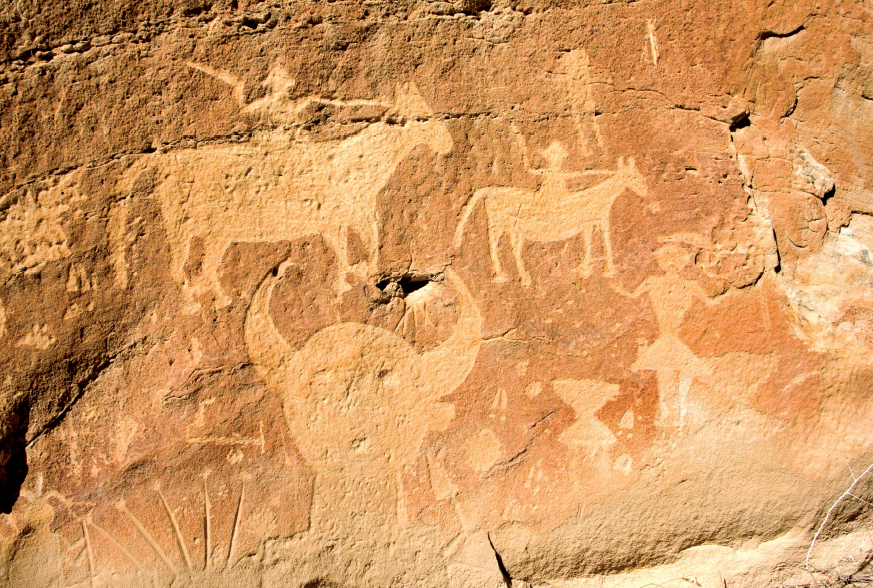Exploring American Histories: Printed Page 69
Exploring American Histories, Value Edition: Printed Page 58
The Pueblo Revolt and Spain’s Fragile Empire
As New France pushed westward and southward, Spain continued to oversee an empire that was spread dangerously thin on its northern reaches. In New Mexico, tensions between Spanish missionaries and encomenderos and the Pueblo nation had simmered for decades (see chapter 2). Relations worsened in the 1670s when a drought led to famine among many area Indians and brought a revival of Indian rituals that the Spaniards viewed as a threat to Christianity. In addition, Spanish forces failed to protect the Pueblos against devastating raids by Apache and Navajo warriors. Finally, Catholic prayers proved unable to stop Pueblo deaths in a 1671 epidemic. When some of the Pueblos returned to their traditional priests, Spanish officials hanged three Indian leaders for idolatry and whipped and incarcerated forty-three others. Among those punished was Popé, a militant Pueblo who upon his release began planning a broad-based revolt.
On August 10, 1680, seventeen thousand Pueblo Indians initiated a coordinated assault on numerous Spanish missions and forts. They destroyed buildings and farms, burned crops and houses, and smeared excrement on Christian altars. The Spaniards retreated to Mexico without launching any significant counterattack.
Yet the Spaniards returned in the 1690s and reconquered parts of New Mexico, aided by growing internal conflict among the Pueblos and fierce Apache raids. The governor general of New Spain worked hard to subdue the province and in 1696 crushed the rebels and opened new lands for settlement. Meanwhile Franciscan missionaries established better relations with the Pueblos by allowing them to retain more indigenous practices and built new missions in the region.

Yet despite the Spanish reconquest, in the long run the Pueblo revolt limited Spanish expansion by strengthening other indigenous peoples in the region. In the aftermath of the revolt, some Pueblo refugees moved north and taught the Navajos how to grow corn, raise sheep, and ride horses. Through the Navajos, the Ute and Comanche peoples also gained access to horses. By the 1730s, the Comanches, who had become a fully equestrian society, launched mounted bison hunts and traded over vast areas. One key trading center formed at Taos in northern New Mexico, where Spanish control was weak. There Comanches sold captives as slaves and gained more horses, metal tools, and guns. Thus the Pueblos provided other Indian nations with the means to support larger populations, wider commercial networks, and more warriors. These nations would continue to contest Spanish rule.
At the same time, Spain sought to reinforce its claims to Texas (named after the Tejas Indians) in response to French settlements in the lower Mississippi valley. Thus, in the early eighteenth century, Spanish missions and forts appeared along the route from San Juan Batista to the border of present-day Louisiana. Although small and scattered, these outposts were meant to ensure Spain’s claim to Texas. But the presence of large and powerful Indian nations, including the Caddo and the Apache, forced Spanish residents to accept many native customs in order to maintain their presence in the region.
Spain also faced challenges to its authority in Florida, where Indians resisted the spread of cattle ranching in the 1670s. Authorities imposed harsh punishments on those killing cows or raiding herds and forced hundreds of Indians to construct a stone fortress, San Marcos, at St. Augustine. Meanwhile the English wooed Florida natives by exchanging European goods for deerskins. Some Indians then moved their settlements north to the Carolina border. The growing tensions along this Anglo-Spanish border would turn violent when Europe itself erupted into war.
Review & Relate
|
What role did the crown play in the expansion of the English North American colonies in the second half of the seventeenth century? |
How did the development of the Spanish and French colonies in the late seventeenth century differ from that of the English colonies? |